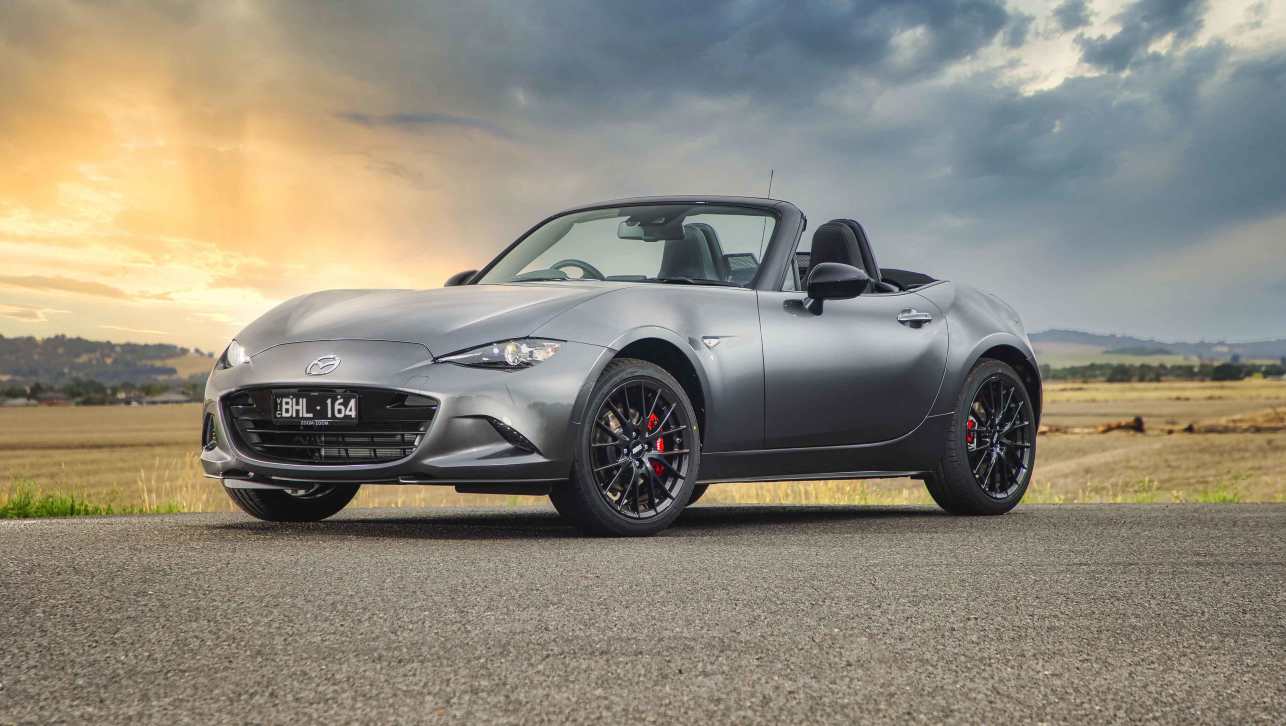The Mazda MX-5 is one of those cars. You know, the ones that everybody loves. It just is. There are no ifs or buts about it; it’s driving nirvana.
Thankfully, the current ND series still has plenty of life in it, but that hasn’t stopped Mazda from giving it another update, even if it is of the minor variety.
That said, the MX-5 does get a sportier flagship grade, dubbed GT RS, as part of the changes to its range, so it’d be rude to not check it out… Read on.
Mazda MX-5 2021: Roadster GT RS
| Engine Type | Inline 4, 2.0L |
|---|---|
| Fuel Type | Premium Unleaded Petrol |
| Fuel Efficiency | 7.1L/100km (combined) |
| Seating | 2 |
| Price From | $38,830 - $45,650 |
| Safety Rating |
|
Is there anything interesting about its design?
9 / 10
Confession time: when the ND series was revealed, I didn’t fall in love at first sight. In fact, I wasn't really sure what was going on up front and at the rear, but I’ve learned the error of my ways over time.
Simply put, this iteration of the MX-5 has aged gracefully, but more so on the outside than inside. Those pinched headlights and that gaping grille look the goods, with its front end made more muscular by the pronounced fenders, an element that carries across to the rear.
Speaking of which, the party at the back still isn’t our favourite angle, but with the right paintwork colour, it can pop in all of the right ways. Yes, those wedge-circle combination tail-lights are divisive, but they are certainly an unmistakeable signature.
Anyway, we’re here to talk about the GT RS, but truth be told, there are only two ways to pick it out of the MX-5 crowd: its aggressive-looking Gunmetal Grey 17-inch BBS forged alloy wheels and red Brembo four-piston brake callipers. Visually, that’s the extent of it.

Like the rest of the MX-5 range, the GT RS is available in two body-styles: the traditional manually operated soft-top Roadster tested here, and the more modern power-operated hardtop RF. The former is quicker to use, while the latter is more secure. Your choice, then.
Either way, the MX-5 more or less looks the same inside, with the GT RS getting a ‘floating’ 7.0-inch central display (exclusively operated via rotary controller) and small multifunction panel next to the proper tachometer and speedometer.

It’s pretty bare-bones, but the GT RS also features black leather upholstery on its seats, steering wheel, gear selector, handbrake (yes, it has one of those old things) and dashboard insert. The minimalist’s sports car, indeed.
How practical is the space inside?
6 / 10
Measuring 3915mm long (with a 2310mm wheelbase), 1735mm wide and 1235mm tall, the Roadster GT RS version of the MX-5 tested here is a very small sports car, so it goes without saying that practicality is not one of its strong suits.
For example, the Roadster version tested here has a minuscule cargo capacity of 130L, while its RF sibling has 127L. Either way, once you stash a couple of soft bags or a small suitcase in it, you won’t be left with much wriggle room.
It doesn't get much better inside, where the central storage bin is tiny. And to make matters worse, there is no glove box … or a single door bin. Not exactly great for in-cabin storage, then.
You do, however, get a pair of removable but shallow cupholders between the seat backrests. Unfortunately, they’re suspended by somewhat flimsy arms, which also don’t afford a lot of confidence, especially with hot drinks.
Connectivity-wise, a single USB-A port is on hand alongside one 12V power outlet – and that’s it. Both are located in the centre stack, right next to a cubby that’s perfectly sized for smartphones.
While it might sound silly to say, it’s worth noting the GT RS doesn’t have any child-seat anchorage points, be they top-tether or ISOFIX, so it’s very much a sports car for adults.
And it’s for that reason you can somewhat forgive its shortcomings on the practicality front, which are not too hard to deal with when driving solo.

Does it represent good value for the price? What features does it come with?
8 / 10
The MX-5 now has three grades, with the unnamed entry-level offering and now-mid-range GT joined by the new flagship GT RS, which is Australian initiative targeted squarely at enthusiasts.
But before we unpack the GT RS, it’s important to note the update increases the cost of carryover variants by $200 but adds wireless Apple CarPlay as standard across the range, although Android Auto remains wired only.
'Deep Crystal Blue' is also now a paintwork option for the MX-5 – and that’s more or less the extent of the latest changes to the existing range. Minor, indeed.
Other standard equipment in the entry-level grade (from $36,090, plus on-road costs) includes dusk-sensing LED headlights and tail-lights, LED daytime running lights (RF), rain-sensing wipers, black 16-inch (Roadster) or 17-inch (RF) alloy wheels, push-button start, a 7.0-inch multimedia system, satellite navigation, digital radio, a six-speaker sound system, single-zone climate control and black cloth upholstery.
The GT grade (from $44,020) adds adaptive LED headlights, LED daytime running lights, silver 17-inch alloy wheels, heated side mirrors, keyless entry, a nine-speaker Bose sound system, heated seats, an auto-dimming rearview mirror and black leather upholstery.

For $1020, a 'Black Roof' package can be added to the two RF GT variants (from $48,100), with it bundling in a black roof and 'Pure White' or burgundy Nappa leather upholstery, with the former a new colour option introduced as part of the update.
The six-speed manual-only GT RS grade commands a $3000 premium over the GT, with the Roadster version tested here priced from $47,020, plus on-road costs, while its RF sibling charges $4080 more.
That said, buyers are compensated for the extra spend with several performance-orientated upgrades, including a Brembo front brake package (280mm ventilated discs with four-piston aluminium calipers).
It not only reduces unsprung mass by 2.0kg, but also includes high-performance pads that Mazda claims provide stronger pedal feedback while improving fade resistance by 26 per cent.
The GT RS also gets Gunmetal Grey 17-inch BBS forged alloy wheels with Bridgestone Potenza S001 tyres (205/45) as well as Bilstein gas-pressurised dampers and a solid alloy strut tower brace, both of which the brand says sharpen the responses of the GT RS.

What’s missing? Well, similarly conceived versions of the ND series from the past had body-hugging Recaro sports seats, but the GT RS doesn’t, with Mazda explaining they weren’t considered this time around, although they may return in a future special edition.
When it comes to similarly priced rivals, the Roadster GT RS tested here doesn’t have many. In fact, the Abarth 124 Spider (from $41,990) was just axed, although the Mini Cooper S Convertible (from $51,100) is still around.
What are the key stats for the engine and transmission?
8 / 10
The Roadster’s entry-level grade is powered by a 1.5-litre, naturally aspirated, four-cylinder petrol engine that produces 97kW of power at 7000rpm and 152Nm of torque at 4500rpm.

All other MX-5 variants, including the Roadster GT RS tested here, are motivated by a 2.0-litre unit that develops 135kW at 7000rpm and 205Nm at 4000rpm.
Either way, drive is sent to the rear wheels via a six-speed manual or a six-speed (torque-converter) automatic. Again, the GT RS grade is only available with the former.
How much fuel does it consume?
9 / 10
Fuel consumption on the combined-cycle test (ADR 81/02) for manual 1.5-litre Roadsters is 6.2 litres per 100km, while their automatic siblings drink 6.4L/100km.
Manual 2.0-litre Roadsters (including the GT RS tested here) manage 6.8L/100km, while their automatic counterparts require 7.0L/100km. And finally, manual 2.0-litre RFs need 6.9L/100km, while automatic versions drink 7.2L/100km.
Either way you look at it, they’re pretty good claims for a sports car! That said, in our real-world testing with the Roadster GT RS, we averaged 6.7L/100km over 142km of driving.
Yep, we bettered the claim, which is a rarity – particularly for a sports car. Simply superb. That said, our result primarily came from a mixture of country roads and highways, so it would’ve been higher in the real world. However, we did give it the beans quite a bit…
For reference, the MX-5 has a 45L fuel tank that takes more expensive 95RON petrol at minimum, no matter the engine option.
Warranty & Safety Rating
What safety equipment is fitted? What safety rating?
7 / 10
ANCAP awarded the MX-5 its maximum five-star safety rating in 2016, but the goalposts have moved significantly in the years since.
Either way, advanced driver-assist systems in the entry-level grade include front autonomous emergency braking (AEB), blind-spot monitoring, rear cross-traffic alert, cruise control, traffic sign recognition, driver attention alert and a reversing camera, while the GT and the GT RS tested here add rear AEB, lane departure warning and rear parking sensors.
Lane-keep and steering assist would be nice additions alongside adaptive cruise control with stop and go functionality, but they might have to wait until the next-generation MX-5 – if there is one. Fingers crossed!
Other range-wide standard safety equipment includes four airbags (dual front and side) and the usual electronic traction and stability control systems.
What does it cost to own? What warranty is offered?
8 / 10
As with all Mazda models, the MX-5 range comes with a five-year/unlimited-kilometre warranty with five years of roadside assistance, both of which are average when compared to Kia’s market-leading seven-year terms with ‘no strings attached.'
Service intervals for the Roadster GT RS tested here are 12 months or 10,000km, with the distance on the shorter side, although capped-price servicing is available for the first five visits, costing $2041 in total for any variant at the time of the writing, which is not too bad.
What's it like to drive?
9 / 10
We may have given it away in the introduction, but the MX-5 is one of the most enjoyable drives out there, and pleasingly, it’s even better in GT RS form.
Again, the GT RS takes the MX-5’s suspension set-up (double-wishbone front and multi-link rear axles) and adds Bilstein gas-pressurised dampers and a solid alloy strut tower brace to make it both better and worse.
Well, what I mean to say is there’s a trade-off, with the jitteriness of the GT RS noticeable from the moment you accelerate for the first time. Indeed, you’d really want to try before you buy, because the ride certainly isn’t for everyone.
That said, the upshot is how these upgrades make the MX-5 even flatter through the corners. It really doesn’t matter how hard you turn in; it will remain locked down. And given the already staggering way in which it pivots, there are almost no handling complaints.
Of course, part of this divine experience is the MX-5’s electric power steering, which goes against the grain by being well-weighted while offering plenty of feel. It might not be the hydraulic set-up of previous iterations, but it’s still damn good.
Another ingredient in the GT RS recipe is the Brembo front brake package (280mm ventilated discs with four-piston aluminium calipers and high-performance pads), and it too delivers the goods, providing excellent stopping power and pedal feel.
Aside from all of that, the GT RS is like any other MX-5 with the same engine-transmission combination, which is a very good thing – mostly.
The 2.0-litre naturally aspirated four-cylinder engine is hilariously good fun, with its free-revving nature encouraging you to push towards the redline with every upshift, and with peak power (135kW) developed at a screaming 7000rpm, you almost have to.

See, it’s no secret this unit is short on torque, particularly down low, and its maximum (205Nm) is produced at 4000rpm, so you really have to get friendly with the right pedal, which is easy to do, of course. That’s not to say it’s not fun, though…
Key to this highly enjoyable experience is the six-speed manual tested here. There aren’t many boxes it doesn’t tick, as it’s got a perfectly weighted clutch, a short throw and well-judged ratios working in its favour, after all.
It’s worth noting six-speed manual versions of the MX-5, including the GT RS tested here, get a rear limited-slip differential, while their six-speed torque-converter automatic siblings miss out on the extra mechanical cornering grip.
Verdict
If you can’t tell already, the MX-5 is an old favourite, and thanks to the new GT RS, the breed has been improved yet again.
Considering it has enthusiasts squarely in its sights, every single one of the GT RS’ upgrades are worthwhile, although the resulting ride certainly isn’t for everyone.
And aside from bringing back the Recaro sports seats, we can’t help but hope a return to supercharging is the next step in the MX-5 evolution…
Pricing Guides


















































.jpg)




.jpg)
.jpg)


.jpg)


.jpg)

.jpg)
Comments